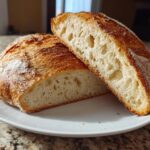Crusty Italian bread has always been the heart of my family meals. I remember my nonna, with flour dusting her apron, pulling warm loaves from the oven. The smell of baking bread filled her tiny kitchen, a scent I still associate with comfort and home. This simple pleasure led me on a quest to perfect my own crusty Italian bread recipe. I’ve discovered that making this easy homemade crusty bread is not just about ingredients; it’s about patience and love. It’s truly the best crusty bread for dipping, and I promise you, you’ll feel that same warmth when you pull your own golden loaf out of the oven. Let’s get cooking!
Why You’ll Love This Crusty Italian Bread
There are so many reasons to fall in love with making your own crusty Italian bread at home. I’ve found it’s not just incredibly satisfying, but it also brings a touch of authentic Italian tradition right to your kitchen. Here’s why I think you’ll adore this recipe:
- It boasts an irresistible golden crust and a wonderfully soft, airy interior.
- This homemade crusty bread is surprisingly simple to prepare, even for beginners.
- You’ll enjoy the immense satisfaction of baking your own delicious bread from scratch.
- It’s incredibly versatile, perfect for dipping, sandwiches, or alongside any meal.
- Making this homemade crusty bread is far more budget-friendly than buying it from a bakery.
- The aroma alone will make your home feel warm and inviting.
Ingredients for Crusty Italian Bread
To create this truly authentic Italian bread, you’ll need just a few simple ingredients. I love how humble components can come together to make something so incredibly delicious and satisfying. Each ingredient plays a crucial role in developing that perfect texture and flavor.
- 3 cups (360g) all-purpose flour – I use unbleached all-purpose for a consistent crumb.
- 1 teaspoon instant yeast – This is what gives our crusty Italian bread its beautiful rise without needing a long proof.
- 1 teaspoon salt – Essential for flavor and controlling the yeast’s activity; don’t skip this!
- 1.5 cups (360ml) warm water (105-115°F / 40-46°C) – The warmth activates the yeast, leading to a bubbly, airy dough.
- 1 tablespoon olive oil – A touch of olive oil adds richness and a subtle flavor, characteristic of traditional Italian bread.
How to Make Crusty Italian Bread
Making your own crusty Italian bread at home is a truly rewarding experience, and I promise you, it’s easier than you think! Follow these steps carefully to achieve that perfect golden crust and airy interior that makes this bread so irresistible. Pay attention to the details, and you’ll be pulling a beautiful loaf from your oven in no time.
- Step 1: In a large mixing bowl, combine your 3 cups all-purpose flour, 1 teaspoon instant yeast, and 1 teaspoon salt. Give them a good whisk to ensure everything is evenly distributed. This dry mix is the foundation for your delicious loaf.
- Step 2: Gradually add the 1.5 cups warm water and 1 tablespoon olive oil to the dry ingredients. Stir with a sturdy wooden spoon or a spatula until a shaggy, somewhat sticky dough forms. Don’t worry if it looks a little messy; that’s exactly how it should be at this stage.
- Step 3: Cover the bowl tightly with plastic wrap or a clean kitchen towel. Place the bowl in a warm, draft-free spot and let the dough rise for 1.5 to 2 hours, or until it has visibly doubled in size. This slow rise is crucial for developing the deep, authentic Italian bread flavor we’re aiming for. It’s truly magical to watch it transform!
- Step 4: Once risen, gently punch down the dough to release the air. This helps to create a more even texture. Turn the dough out onto a lightly floured surface.
- Step 5: Shape the dough into a rustic loaf. You can make it a traditional oblong shape or a round boule, whichever you prefer for your homemade crusty bread. I find a gentle touch here helps maintain the airy structure.
- Step 6: Carefully transfer the shaped dough to a baking sheet lined with parchment paper. Cover it loosely with plastic wrap or a kitchen towel and let it rest for another 30 minutes. This second rise, often called proofing, contributes significantly to the light and open crumb of your finished bread.
- Step 7: While your dough is on its second rise, preheat your oven to 450°F (232°C). If you have a baking stone or cast-iron skillet, place it in the oven to preheat as well. For an extra crispy crust, place a shallow pan of water on the bottom rack of your oven to create steam.
- Step 8: Once the oven is preheated, carefully transfer the dough onto the hot baking stone or skillet. If not using, simply bake on the parchment-lined baking sheet.
- Step 9: Bake for 25-35 minutes, or until your crusty Italian bread is a beautiful golden brown and sounds hollow when tapped on the bottom. The high heat is key to achieving that signature crunchy crust.
- Step 10: Remove the bread from the oven and immediately transfer it to a wire rack to cool completely. This step is non-negotiable for the best texture; resist the urge to slice it too soon! Cooling allows the internal structure to set and the crust to become truly crisp. This is how to make crusty Italian bread that rivals any bakery.

Pro Tips for the Best Crusty Italian Bread
I’ve learned a few invaluable tricks over the years that consistently elevate my crusty Italian bread from good to absolutely amazing. These simple tips will ensure your loaf comes out with that perfect golden crust and airy interior every single time. Paying attention to these details can make all the difference in achieving bakery-quality results right in your own kitchen.
- Use a kitchen scale for accuracy; measuring flour by volume can be inconsistent.
- Don’t over-knead the dough; a gentle touch leads to a lighter crumb.
- Always preheat your oven and any baking stones thoroughly for a better crust.
- Add steam to your oven during the first 10-15 minutes of baking for maximum crispness.
- Allow the bread to cool completely on a wire rack before slicing to prevent a gummy texture.
What’s the secret to perfect crusty Italian bread?
The real secret to incredibly crusty Italian bread lies in high heat and steam during baking. The initial blast of heat sets the crust, while the steam keeps it pliable long enough to expand, creating those beautiful bubbles and that signature crackle. This is why Italian bread is crusty and so delicious.
Can I make crusty Italian bread ahead of time?
Absolutely! You can prepare the dough and let it do its first rise in the refrigerator overnight (up to 24 hours). Just be sure to bring it back to room temperature for about an hour before shaping and the second rise. This flexibility makes baking fresh crusty Italian bread so much easier.
How do I avoid common mistakes with crusty Italian bread?
To avoid common pitfalls, don’t use too much flour when shaping, as this can make your crusty Italian bread dense. Secondly, always ensure your water temperature is correct for yeast activation. Finally, resist the urge to open the oven door frequently, especially during the initial baking phase, to maintain that crucial heat and steam.
Best Ways to Serve Crusty Italian Bread
Once you’ve baked your perfect loaf of crusty Italian bread, the serving possibilities are endless! I love how versatile this bread is, making it a fantastic addition to almost any meal. Its firm crust and tender interior make it ideal for soaking up delicious flavors. Here are some of my favorite ways to enjoy it:
- It’s truly the best crusty bread for dipping! Serve warm slices with a good quality extra virgin olive oil, a sprinkle of flaky sea salt, and some balsamic vinegar. This simple pairing is always a crowd-pleaser.
- Pair it with hearty Italian pasta dishes, like a rich bolognese or a vibrant pesto. The bread is perfect for mopping up every last bit of sauce from your plate.
- Use it as the base for incredible bruschetta. Toast slices lightly, rub with garlic, and top with fresh diced tomatoes, basil, and a drizzle of olive oil. It’s a fantastic appetizer that highlights the bread’s texture.
- Serve alongside a comforting bowl of soup or a fresh, crisp salad. The bread adds a wonderful textural contrast and helps make the meal more substantial.
Nutrition Facts for Crusty Italian Bread
I know many of you are curious about the nutritional value of your homemade creations, and this crusty Italian bread is no exception. While I focus on taste and enjoyment, it’s good to have an idea of what you’re fueling your body with. Here’s a breakdown per serving, based on this recipe yielding one loaf, which I typically divide into 8 servings:
- Calories: 190
- Fat: 1.5g
- Saturated Fat: 0.2g
- Carbohydrates: 38g
- Fiber: 1g
- Sugar: 0g
- Protein: 6g
- Sodium: 290mg
Nutritional values are estimates and may vary based on specific ingredients used and portion sizes. This makes a wonderful addition to any balanced meal!
How to Store and Reheat Crusty Italian Bread
Once you’ve enjoyed your freshly baked crusty Italian bread, proper storage is key to preserving its wonderful texture and flavor. I always recommend letting your loaf cool completely on a wire rack before storing it. This prevents condensation which can make your beautiful crust soggy.
For short-term storage, up to 3-4 days, I simply place my homemade crusty bread in a paper bag or wrap it loosely in a clean kitchen towel at room temperature. Avoid airtight containers, as they trap moisture and soften the crust. If you need to keep it longer, this bread freezes beautifully.
To freeze, wrap the cooled loaf tightly in plastic wrap, then an additional layer of aluminum foil. It will keep well in the freezer for up to 3 months. When you’re ready to enjoy it again, thaw the frozen bread at room temperature, then refresh it in a 350°F (175°C) oven for 5-10 minutes. This brings back that amazing crust and warm, soft interior, making your homemade crusty bread taste fresh from the oven!
Frequently Asked Questions About Crusty Italian Bread
Can I use a stand mixer to make crusty Italian bread?
Absolutely! While I prefer the hands-on feel, a stand mixer with a dough hook makes the initial mixing even easier. Just mix on low speed until a shaggy dough forms, then proceed with the first rise. This can save you a bit of arm work, especially if you’re making a double batch of this wonderful crusty Italian bread.
What’s the best flour for authentic Italian bread?
For a truly traditional Italian bread, I find unbleached all-purpose flour works wonderfully. Some bakers prefer bread flour for a chewier crumb due to its higher protein content. Experiment to see what you like best, but for that classic, airy texture in your crusty Italian bread, good quality all-purpose is perfect.
Why is my homemade crusty bread not crusty?
Several factors can prevent your crusty Italian bread from being truly crusty. Ensure your oven is fully preheated, and consider using a baking stone or preheated cast iron skillet. Most importantly, create steam in your oven during the first part of baking. A pan of hot water or spraying the oven walls can work wonders for that crisp, golden crust on your traditional Italian bread.
Can I add herbs or cheese to this crusty Italian bread recipe?
Yes, you can! For a delightful variation, I often add dried rosemary or a mix of Italian herbs to the dough during the initial mixing phase. You could also fold in some finely grated Parmesan cheese. Just remember that additions can sometimes affect the dough’s hydration, so you might need to slightly adjust the water content for your perfect crusty Italian bread.
Variations of Crusty Italian Bread You Can Try
Once you’ve mastered the basic crusty Italian bread recipe, don’t be afraid to experiment! I love playing with different flavors and textures to customize my loaves. These variations offer exciting ways to enjoy this classic bread, from dietary adjustments to unique flavor profiles, ensuring your baking adventures are always fresh and exciting.
- Herbed Rustic Italian Bread: For a delightful aromatic twist, incorporate 1-2 tablespoons of dried herbs like rosemary, oregano, or a mixed Italian seasoning blend into the dough during the initial mixing stage. This adds a wonderful fragrance and flavor that pairs beautifully with olive oil.
- Garlic Parmesan Variation: Mix in 1/4 cup of grated Parmesan cheese and 2-3 cloves of minced garlic with the dry ingredients. This creates a savory version of crusty Italian bread that’s perfect alongside pasta dishes or as a flavorful appetizer.
- Whole Wheat Rustic Loaf: For a slightly heartier and nuttier flavor, substitute up to half of the all-purpose flour with whole wheat flour. You might need to add an extra tablespoon or two of water to maintain the dough’s hydration, as whole wheat flour absorbs more liquid.
- No-Knead Sourdough Italian Bread: If you have an active sourdough starter, you can adapt this recipe to be a no-knead sourdough version. This will give your crusty Italian bread a more complex, tangy flavor profile and an even chewier crumb, truly embracing the rustic artisan bread feel.

Crusty Italian Bread: Your 10-Step Golden Loaf Secret
- Total Time: 2 hours 50 minutes
- Yield: 1 loaf 1x
- Diet: Vegetarian
Description
This crusty Italian bread recipe creates a delightful, easy-to-make loaf perfect for any meal. Enjoy homemade crusty bread with a beautiful golden crust and a soft, airy interior. This traditional Italian bread is ideal for dipping in olive oil, serving with pasta, or making delicious bruschetta.
Ingredients
- 3 cups (360g) all-purpose flour
- 1 teaspoon instant yeast
- 1 teaspoon salt
- 1.5 cups (360ml) warm water (105-115°F / 40-46°C)
- 1 tablespoon olive oil
Instructions
- In a large bowl, combine the flour, instant yeast, and salt. Mix well.
- Gradually add the warm water and olive oil to the dry ingredients. Stir with a wooden spoon or a spatula until a shaggy dough forms.
- Cover the bowl with plastic wrap or a clean kitchen towel and let the dough rise in a warm place for 1.5 to 2 hours, or until doubled in size. This slow rise helps develop the authentic Italian bread flavor.
- Gently punch down the risen dough to release air.
- On a lightly floured surface, shape the dough into a rustic Italian bread loaf. You can make a round or oblong shape for your homemade crusty bread.
- Place the shaped dough on a baking sheet lined with parchment paper. Cover loosely and let it rest for another 30 minutes. This second rise contributes to the light texture of the crusty artisan bread.
- Preheat your oven to 450°F (232°C) with a baking stone or cast-iron skillet inside, if you have one. For extra crust, place a shallow pan of water on the bottom rack of the oven.
- Carefully transfer the dough to the preheated baking stone or skillet. If not using, simply bake on the parchment-lined baking sheet.
- Bake for 25-35 minutes, or until the crusty Italian bread is golden brown and sounds hollow when tapped on the bottom. The high heat ensures a perfect crust.
- Remove the bread from the oven and let it cool completely on a wire rack before slicing. This step is crucial for the best crusty bread texture.
Notes
- For an even crispier crust on your homemade crusty bread, spray the oven walls with water a few times during the first 10 minutes of baking.
- Leftover crusty Italian bread can be stored at room temperature in an airtight container for up to 3 days.
- This traditional Italian bread also freezes well. Wrap tightly in plastic wrap and then foil for up to 3 months.
- Experiment with adding herbs like rosemary or dried oregano to the dough for a different flavor profile in your rustic Italian bread.
- Prep Time: 20 minutes
- Cook Time: 30 minutes
- Category: Bread
- Method: Baking
- Cuisine: Italian
Nutrition
- Serving Size: 1/8 loaf
- Calories: 190
- Sugar: 0g
- Sodium: 290mg
- Fat: 1.5g
- Saturated Fat: 0.2g
- Unsaturated Fat: 1g
- Trans Fat: 0g
- Carbohydrates: 38g
- Fiber: 1g
- Protein: 6g
- Cholesterol: 0mg
Keywords: crusty Italian bread, crusty Italian bread recipe, authentic Italian bread, traditional Italian bread, homemade crusty bread, how to make crusty Italian bread, rustic Italian bread, pane di casa recipe, crusty bread for bruschetta













Leave a Reply